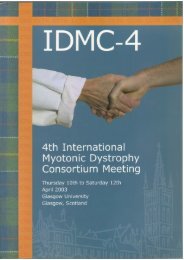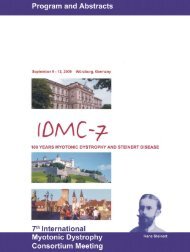You also want an ePaper? Increase the reach of your titles
YUMPU automatically turns print PDFs into web optimized ePapers that Google loves.
Abstract No : 26<br />
ORAL PRESENTATIONS<br />
TRANSCRIPTIONAL PROFILE OF TRANSGENIC MICE EXPRESSING<br />
AN EXPANDED CUG REPEAT<br />
Osborne R.J., Welle S. and Thornton C.A.<br />
University of Rochester, Department of Neurology, Rochester (NY), USA, 16642<br />
HSALR transgenic mice expressing CUG expansion RNA in skeletal muscle have a DM-like<br />
phenotype. For several genes these mice replicate the abnormal regulation of alternative<br />
splicing seen in DM. In an attempt to identify additional pathways affected by<br />
repeat expansion RNA, we used expression microarrays to compare skeletal muscle in<br />
two independent founder lines of HSALR mice (lines 20b and 41) and in wild-type (WT)<br />
mice of the same genetic background (n=6 per group, no sample pooling). To obtain<br />
comprehensive coverage of the mouse transcriptome we used Affymetrix 430A and B<br />
chips (45,000 probe sets). These analyses identified 45 probe sets that were differentially<br />
expressed in both HSALR20b and HSALR41 versus WT comparisons (P≤0.01, foldchange<br />
≥2). We postulated that some of these changes resulted from responses to<br />
<strong>myotonic</strong> discharges or nonspecific muscle injury. To eliminate these genes from consideration,<br />
we also studied adr (ClC-1 null) mice and their WT controls (n=3 per group, no<br />
sample pooling). We chose adr mice because they have severe myotonia and modest upregulation<br />
of regeneration dependent genes. After filtering out probe sets showing similar<br />
changes in adr and HSALR mice, we were left with 24 genes that were up-regulated<br />
and 4 genes that were down-regulated in both HSALR founder lines. Of note, none of<br />
these genes have been previously implicated in DM pathogenesis. We conclude that the<br />
influence of poly(CUG) accumulation on gene expression is surprisingly restricted, even<br />
in myonuclei that have a heavy burden of repeat expansion RNA. The function of these<br />
genes suggests signaling pathways that might be involved in the DM disease process.<br />
QUEBEC 2005 47




